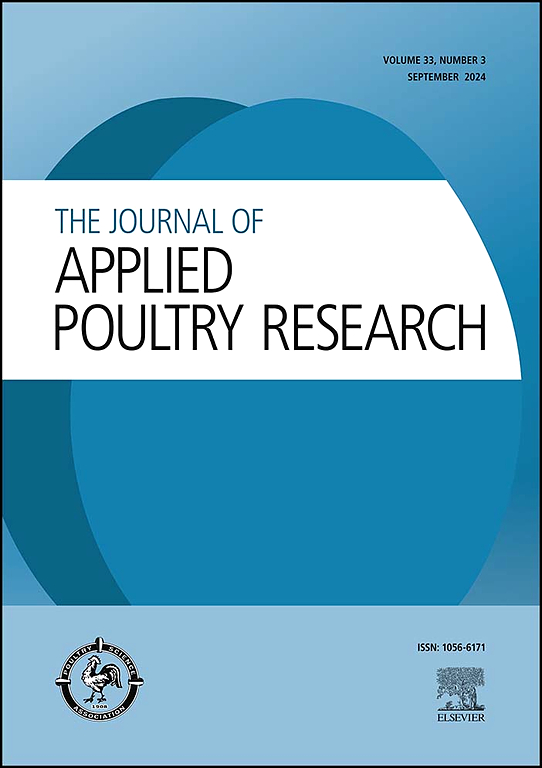Effects of palm oil, canola oil, and rice bran oil on growth performance, blood biochemistry, and intestinal morphology in young chicks
IF 2
3区 农林科学
Q2 AGRICULTURE, DAIRY & ANIMAL SCIENCE
引用次数: 0
Abstract
A total of 216 Ross 308 broiler chicks were randomly allocated to a 3 × 2 factorial arrangement, consisting of three dietary treatments (palm oil [PO], canola oil [CO], and rice bran oil [RBO], each at 40 g/kg) and two sexes (male and female). Each dietary treatment was replicated 6 times per sex (six male and six female replicates), resulting in a total of 12 replicates per treatment, with 6 birds per replicate. Results showed that different oil sources had no significant effect (P > 0.05) on body weight, weight gain (WG), feed intake, and feed conversion ratio (FCR). The effects of dietary oil sources on duodenal morphology in broiler chickens revealed several significant outcomes. In males, feeding CO tended to increase villus height, and significantly reduced crypt depth, resulting in a higher (P < 0.001) VH/CP ratio compared to PO and RBO. In females, feeding RBO produced the most favourable morphology, with the highest villus height, lowest crypt depth, and greatest VH/CP ratio among treatments (P < 0.001). While dietary oil sources did not significantly affect the relative weights of internal organs, a significant effect (P = 0.01) of sex was observed, with female broiler chickens having greater gizzard weights than males. Feeding RBO increased liver redness and crude protein content (P = 0.01 and P < 0.001, respectively). Females showed higher redness (P = 0.002), while males tended to have greater protein levels (P = 0.06). Serum alanine aminotransferase (ALT), aspartate aminotransferase (AST), alkaline phosphatase (ALP), and lactate dehydrogenase (LDH) levels were not significantly affected (P > 0.05) by sex, oil source, or their interaction. In conclusion, dietary inclusion of PO, CO, or RBO resulted in comparable growth performance in broiler chickens, with no significant differences detected. However, the type of oil may still impact specific physiological aspects, especially duodenal morphology and liver composition and quality. Further studies are needed to confirm these findings across breeds and environments.
棕榈油、菜籽油和米糠油对雏鸡生长性能、血液生化和肠道形态的影响
试验选用216只罗斯308肉鸡,随机分为3组,分别饲喂40 g/kg的棕榈油、菜籽油和米糠油,雌雄对照。每个饲粮处理每性别重复6次(6个雄性和6个雌性重复),每个处理共12个重复,每个重复6只鸡。结果表明,不同油源对肉鸡体重、增重、采食量和饲料系数均无显著影响(P > 0.05)。饲粮油源对肉鸡十二指肠形态的影响有几个显著的结果。在雄性中,饲喂CO会增加绒毛高度,显著降低隐窝深度,导致VH/CP比(P < 0.001)高于PO和RBO。在雌性中,喂食RBO产生了最有利的形态,绒毛高度最高,隐窝深度最低,VH/CP比最高(P < 0.001)。饲粮油源对内脏相对重量的影响不显著,但性别对内脏相对重量的影响极显著(P = 0.01),雌性肉鸡的砂囊重量大于雄性。饲喂RBO可显著提高肝脏红度和粗蛋白质含量(P = 0.01和P <; 0.001)。女性表现出更高的红度(P = 0.002),而男性往往具有更高的蛋白质水平(P = 0.06)。血清丙氨酸转氨酶(ALT)、天冬氨酸转氨酶(AST)、碱性磷酸酶(ALP)和乳酸脱氢酶(LDH)水平不受性别、油源及其相互作用的显著影响(P > 0.05)。综上所述,饲粮中添加PO、CO或RBO对肉鸡的生长性能影响相当,且无显著差异。然而,油的类型仍然可能影响特定的生理方面,特别是十二指肠形态和肝脏组成和质量。需要进一步的研究来证实这些跨品种和环境的发现。
本文章由计算机程序翻译,如有差异,请以英文原文为准。
求助全文
约1分钟内获得全文
求助全文
来源期刊

Journal of Applied Poultry Research
农林科学-奶制品与动物科学
CiteScore
4.10
自引率
10.50%
发文量
80
审稿时长
104 days
期刊介绍:
The Journal of Applied Poultry Research (JAPR) publishes original research reports, field reports, and reviews on breeding, hatching, health and disease, layer management, meat bird processing and products, meat bird management, microbiology, food safety, nutrition, environment, sanitation, welfare, and economics. As of January 2020, JAPR will become an Open Access journal with no subscription charges, meaning authors who publish here can make their research immediately, permanently, and freely accessible worldwide while retaining copyright to their work. Papers submitted for publication after October 1, 2019 will be published as Open Access papers.
The readers of JAPR are in education, extension, industry, and government, including research, teaching, administration, veterinary medicine, management, production, quality assurance, product development, and technical services. Nutritionists, breeder flock supervisors, production managers, microbiologists, laboratory personnel, food safety and sanitation managers, poultry processing managers, feed manufacturers, and egg producers use JAPR to keep up with current applied poultry research.
 求助内容:
求助内容: 应助结果提醒方式:
应助结果提醒方式:


